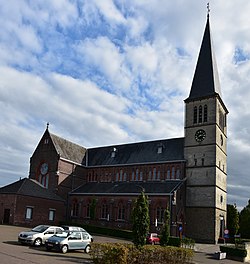Eigenbilzen | |
|---|---|
Village and former municipality | |
 Saint-Ursula Church | |
| Coordinates: 50°52′32″N5°34′30″E / 50.875556°N 5.5750°E | |
| Country | |
| Community | Flemish Community |
| Province | Limburg |
| Municipality | Bilzen |
| Area | |
• Total | 8.23 km2 (3.18 sq mi) |
| Population (2013) [1] | |
• Total | 2,317 |
| • Density | 282/km2 (729/sq mi) |
| Time zone | CET |
Eigenbilzen is a village and former municipality in the Bilzen municipality of the Limburg province in the Flemish Community of Belgium. Eigenbilzen was an independent municipality until 1977 when it merged into Bilzen during the fusion of the Belgian municipalities. [2]

